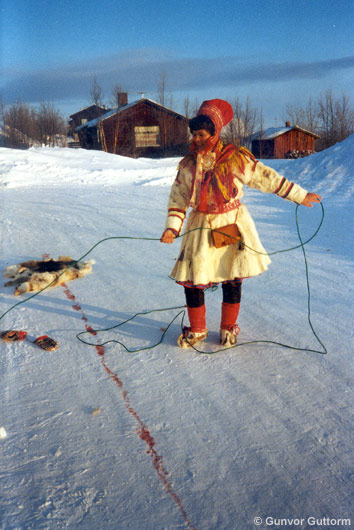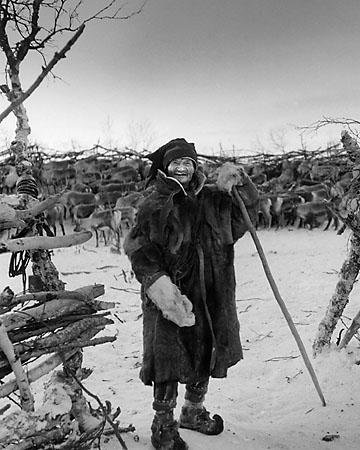Porontalja: Duodji: esineet, raaka-aine jne.
Porontalja: Duodji: esineet, raaka-aine jne.
Reindeer skin: Duodji: tools, materials etc.
The making of clothes has been very important among the Saami. Many still master the old techniques connected to the making of clothing. It was absolutely necessary to be able to sew clothes from reindeer skin and other skin in order not to freeze to death. Those who kept warm survived up in the north. The seamstresses of today sew in order to practise their skill to be able to decorate themselves or to dress up others in their clothes. Saami traditional clothes function today as a label of the family and they are practical to use.
Duollji, the word for reindeer skin, tells that the Saami have used reindeer skin for their handicraft for a long time. The word is a proto Saami word that belongs to life as hunters, and thus the Saami have started to make clothing out of reindeer skin at an early stage. The reindeer skin is prepared, the hairs are removed and the skin is made soft by using a jiehkku, the characteristic circumpolar skin scraper, which is an S-shaped iron implement fastened in the middle of the wooden handle. The tanned hide is prepared the same way people have done for hundreds of years: the skin is left in water until the hairs loosen, the skin is tanned with bark, all sinews are removed with the scraper and the skin is finally made soft by rubbing it by hand. There are of course other ways of preparing skin, using machines.
The fur coat is made from the skin of reindeer calves. It can be made of pelt with short hairs, considered the most beautiful. The colour may be evenly white or dark brown. The fur for a short hair fur coat must be taken from calves slaughtered in the autumn or a little later. Fur with thick and long hair is used for making fur coats for daily outdoor work up in the mountains. The different way of decorating a fur coat indicates from which area it comes from. Those who still make fur coats do it by hand. The fur coat skin is normally prepared by using the scraper and no chemicals are added when tanning in order to make the skin warm and waterproof. Nowadays, fur coats are made from other skins than just the hides of reindeer calves. These skins are prepared in factories and made using sewing machines.
Hats can be made from the fur of reindeer calves, both for women and men and for children. There are different kinds of hats, again depending on area and family.
Sistegákti is the costume made of tanned hide. This was formerly a summer garment while the fur coat was used in the winter. Tanned reindeer costumes were still made a while ago, but then more for special occasions rather than every day usage. Today the sistegákti is definitely a garment to dress up in.
Duodji: tools, materials etc..
Table of contents: Living and household, clothing etc.

